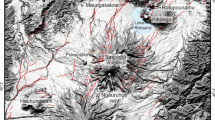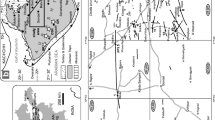Abstract
Strong compositional zonation of the 34 Ma Grizzly Peak Tuff in west-central Colorado is attended by non-monotonic trends in O, Sr, Nd, and Pb isotope ratios. Fiamme from the tuff cluster in chemical compositions and petrographic characteristics, indicating the magma chamber was not continuously zoned but consisted of at least seven compositional layers. The most mafic magma erupted (57 wt% SiO2, fiamme group 7) had δ18O= +8.5, initial 87Sr/86Sr=0.7099, εNd, and 206Pb/204Pb=17.80, suggesting that the magma was produced by ∼50% fractional crystallization of basaltic magma that assimilated 20 to 40 wt% Proterozoic crust. Isotopic compositions of more evolved parts of the chamber (up to 77 wt% SiO2, fiamme group 1) depart from the mafic “base-level” composition of fiamme group 7, and reflect late-stage assimilation that occurred largely after compositional layering was established. δ18O values decrease by as much as 1.5‰ from fiamme groups 7 through 4, indicating assimilation of hydrothermally altered roof rocks. δ18O values abruptly inerease by up to 1.5‰ between fiamme groups 4 and 3. This discontinuity is interpreted to reflect evolution in an asymmetric chamber that had a split-level roof, allowing assimilation of wall rocks that varied vertically in degree of hydrothermal alteration. This chamber geometry is also supported by collapse structures in the caldera. Late-stage assimilation of heterogeneous wall rocks is also indicated by variations in Sr, Nd, and Pb isotope ratios. Large Sr isotope disequilibrium exists between some phenocrysts and whole-rock fiamme, and initial 87Sr/86Sr ratios in phenocrysts are as high as 0.7170. ε values regularly increase from-13.0 in fiamme group 7 to-11.3 in fiamme group 3, and then decrease to-12.2 in fiamme group 1. 206Pb/204Pb ratios generally increase from 17.80 to 17.94 for fiamme groups 7 through 1. The rhyolitic parts of the Grizzly Peak Tuff have isotopic compositions that could be attributed to a purely crustal melt. It is unlikely, however, that the mafic parts of the tuff were generated by crustal melting, and the compositional and isotopic variations across the entire zonation of the tuff are best explained by fractional crystallization of mantle-derived magmas, accompanied by extensive assimilation of Proterozoic crust.
Similar content being viewed by others
References
Bacon CR, Adami LH, Lanphere MA (1989) Direct evidence for the origin of low-18O silicic magmas: quenched samples of a magma chamber's partially-fused granitoid walls, Crater Lake, Oregon. Earth Planet Sci Lett 96:199–208
Bottinga Y, Javoy M (1975) Oxygen isotope partitioning among the minerals in igneous and metamorphic rocks. Rev Geophys Space Phys 13:401–418
DePaolo DJ (1981a) Neodymium isotopes in the Colorado Front Range and crust-mantle evolution in the Proterozoic. Nature 291:193–196
DePaolo DJ (1981b) Trace element and isotopic effects of combined wall rock assimilation and fractional crystallization. Earth Planet Sci Lett 53:189–202
Doe BR, Lipman PW, Hedge CE, Kurasawa H (1969) Primitive and contaminated basalts from the southern Rocky Mountains, U.S.A. Contrib Mineral Petrol 21:142–156
Dickin AP, Exley RA, Smith BM (1980) Isotopic measurement of Sr and O exchange between meteoric-hydrothermal fluid and the Coire Vaigneich granophyre, Isle of Skye, N.W. Scotland. Earth Planet Sci Lett 51:58–70
Farmer GL, DePaolo DJ (1983) Origin of Mesozoic and Tertiary granite in the western United States and implications for pre-Mesozoic crustal structure 1. Nd and Sr isotopic studies in the geocline of the northern Great Basin. J Geophy Res 88:3379–3401
Farmer GL, DePaolo DJ (1984) Origin of Mesozoic and Tertiary granite in western United States and implications for pre-Mesozoic crustal structure 2. Nd and Sr isotopic studies of unmineralized and Cu- and Mo-mineralized granite in the Precambrian craton. J Geophys Res 89:10141–10160
Fridrich CJ (1987) The Grizzly PEak caldera, Colorado: Structure and petrology of a deeply dissected resurgent ash-flow caldera. PhD thesis, Standford University
Fridrich CJ, Mahood GA (1984) Reverse zoning in the resurgent intrusions of the Grizzly Peak cauldron, Sawatch Range, Colorado. Geol Soc Am Bull 95:779–787
Fridrich CJ, Mahood GA (1987) Compositional layers in the zoned magma chamber of the Grizzly Peak Tuff. Geology 15:299–303
Fridrich CJ, Smith RP, DeWitt E, McKee EH (1990) Structural, eruptive and intrusive evolution of the Grizzly Peak caldera, Sawatch Range, Colorado. Geol Soc Am Bull (in press)
Friedman I, Lipman PW, Obradovich JD, Gleason JD, Christiansen RL (1974) Meteroric water in magmas. Science 184:1069–1072
Gregory RT, Criss RE (1986) Isotopic exchange in open and closed systems. In: Valley JW, Taylor HP Jr, O'Neil JR (eds) Reviews in mineralogy 16: Stable isotopes in high temperature geological processes. Mineral Soc Am, pp 91–127
Grunder AL (1987) Low δ18O silicic volcanic rocks at the Calabozos caldera complex, southern Andes. Evidence for upper-crustal contamination. Contrib Mineral Petrol 95:71–81
Halliday AN, Fallick AE, Hutchinson J, Hildreth W (1984) A Nd, Sr and O isotopic investigation into the causes of chemical and isotopic zonation in the Bishop Tuff, California. Earth Planet Sci Lett 68:379–391
Helz RT (1976) Phase relations of basalts in their melting ranges at PH 2O=5 kbar. Part II. Melt compositions. J Petrol 17:139–193
Hildreth W (1981) Gradients in silicic magma chambers: implications for lithospheric magmatism. J Geophys Res 86:10153–19192
Hildreth W, Christiansen RL, O'Neil JR (1984) Catastrophic isotopic modification of rhyolite magma at times of caldera subsidence, Yellowstone Plateau Volcanic Field. J Geophys Res 89:8339–8369
Hildreth W, Moorbath S (1988) Crustal contributions to arc magmatism in the Andes of central Chile. Contrib Mineral Petrol 98:455–489
Jacobsen SB, Wasserburg GJ (1980) Sm-Nd isotopic evolution of chondrites. Earth Planet Sci Lett 50:139–155
Johnson CM (1989) Isotopic zonations in silicic magma chambers. Geology 17:1136–1139
Johnson CM, O'Neil JR (1984) Triple junction magmatism: a geochemical study of Neogene volcanic rocks in western California. Earth Planet Sci Lett 71:241–262
Johnson CM, Thompson RA (1991) Isotopic composition of Oligocene mafic volcanic rocks in the northern Rio Grande rift: evidence for contributions of ancient intraplate and subduction magmatism to evolution of the lithosphere. J Geophys Res (in press)
Johnson CM, Lipman PW, Czamanske GK (1990) H, O, Sr, Nd, and Pb isotope geochemistry of the Latir volcanic field and cogenetic intrusions, New Mexico, and relations between evolution of a continental magmatic center and modifications of the lithosphere. Contrib Mineral Petrol 104:99–124
Kyser TK, O'Neil JR, Carmichael ISE (1982) Genetic relations among basic lavas and ultramafic nodules: evidence from oxygen isotope compositions. Contrib Mineral Petrol 81:88–102
Larson PB, Taylor HP Jr (1986a) 18O/16O ratios in ash-flow tuffs and lavas erupted from the central Nevada caldera complex and the central San Juan caldera complex, Colorado. Contrib Mineral Petrol 92:146–156
Larson PB, Taylor HP Jr (1986b) An oxygen isotope study of hydrothermal alteration in the Lake City caldera, San Juan Mountains, Colorado. J Volcanol Geotherm Res 30:47–82
Leat PT, Thompson RN, Morrison MA, Hendry GL, Dickin AP (1988) Compositionally-diverse Miocene-Recent rift-related magmatism in northwest Colorado: partial melting, and mixing of mafic magmas from 3 different asthenospheric and lithospheric mantle sources. J Petrol Spec Lithosphere Issue:351-377
Leat PT, Thompson RN, Dickin AP, Morrison MA, Hendry GL (1989) Quaternary volcanism in northwestern Colorado: implications for the roles of asthenosphere and lithosphere in the genesis of continental magmas. J Volcanol Geotherm Res 37:291–310
Lipman PW (1967) Mineral and chemical variations within an ashflow sheet from the Aso caldera, Southwestern Japan. Contrib Mineral Petrol 16:300–327
Lipman PW, Friedman I (1975) Interaction of meteoric water with magma: an oxygen isotope study of ash-flow sheets from southern Nevada. Geol Soc Am Bull 86:695–702
Lipman PW, Doe BR, Hedge CE, Steven TA (1978) Petrologic evolution of the San Juan volcanic field, southwestern Colorado: Pb and Sr isotope evidence. Geol Soc Am Bull 89:58–82
Nelson BK, DePaolo DJ (1984) 1,700-Myr greenstone volcanic successions in southwestern North America and isotopic evolution of Proterozoic mantle. Nature 312:143–146
Nelson BK, DePaolo DJ (1985) Rapid production of continental crust 1.7 to 1.9 b. y. ago: Nd isotopic evidence from the basement of the North American mid-continent. Geol Soc Am Bull 96:746–754
Nielson RL (1985) EQUIL: a program for the modeling of lowpressure differentiation processes in natural mafic magma bodies. Comput Geosci 11:531–546
Norton D (1978) Sourcelines, source regions, and pathlines for fluids in hydrothermal systems related to cooling plutons. Econ Geol 73:21–28
Norton D, Knight J (1977) Transport phenomena in hydrothermal systems: cooling plutons. Am J Sci 277:937–981
Pearson RC, Hedge CE, Thomas HH, Stern TW (1966) Geochronology of the St. Kevin granite and neighboring Precambrian rocks, northern Sawatch Range, Colorado. Geol Soc Am Bull 77:1109–1120
Peterman ZE, Hedge CE (1968a) Chronology of Precambrian events in the Front Range, Colorado. Can J Earth Sci 5:749–756
Peterman ZE, Hedge CE (1989b) Age of Precambrian events in the northeastern Front Range, Colorado. J Geophys Res 73:2277–2296
Peterman ZE, Doe BR, Bartel A (1967) Data on the rock GSP-1 (granodiorite) and the isotope-dilution method of analysis for RB and SR. US Geol Surv Prof Pap 575-B:B181-B186
Pollard DD, Johnson AM (1973) Mechanics of growth of some laccolithic intrusions in the Henry Mountains, Utah, II. Bending and failure of overburden layers and sill formation. Tectonophys 18:311–354
Riciputi LR, Johnson CM (1990) Nd and Pb isotope variations in the multicyclic central caldera cluster of the San Juan volcanic field and implications for crustal hybridization. Geology 18:975–978
Shannon JR (1988) Geology of the Mount Aetna cauldron complex, Sawatch Range, Colorado. PhD thesis, Colorado School of Mines, Colo, USA
Simmons EC, Hedge CE (1978) Minor-element and Sr-isotope geochemistry of Tertiary stocks, Colorado Mineral Belt. Contrib Mineral Petrol 67:379–396
Smith RL (1979) Ash-flow magmatism. Geol Soc Am Spec Pap 180:5–27
Stacey JS, Kramers JD (1975) Approximation of terrestrial lead isotope evolution by a two-stage model. Earth Planet Sci Lett 26:207–221
Stein HJ (1985) A lead, strontium, and sulfur isotope study of Laramide-Tertiary intrusions and mineralization in the Colorado Mineral Belt with emphasis on Climax-type porphyry molybdenum systems plus a summary of newly acquired isotopic and rare earth element data, PhD thesis, University of North Carolina, Chapel Hill, N.C., USA
Stein HJ, Crock JG (1990) Late Cretaceous-Tertiary magmatism in the Colorado Mineral Belt: rare earth element and samarium-neodymium isotopic studies. Geol Soc Am Mem 174:195–223
Tatsumoto M (1978) Isotopic composition of lead in oceanic basalt and its implication to mantle evolution. Earth Planet Sci Lett 38:63–67
Taylor HP Jr (1968) The oxygen isotope geochemistry of igenous rocks. Contrib Mineral Petrol 19:1–71
Taylor HP Jr (1988) Oxygen, hydrogen, and strontium isotope constraints on the origin of granites. Trans R Soc Edinburgh. Earth Sci 79:317–338
Valley JW, Taylor HP Jr, O'Neil JR (eds) (1986) Reviews in minealogy 16: Stable isotopes in high temperature geological processes. Mineral Soc Am
Varga RJ, Smith BM (1984) Evolution of the early Oligocene Bonanza caldera, northeast San Juan volcanic field, Colorado. J Geophys Res 89:8679–8694
Author information
Authors and Affiliations
Rights and permissions
About this article
Cite this article
Johnson, C.M., Fridrich, C.J. Non-monotonic chemical and O, Sr, Nd, and Pb isotope zonations and heterogeneity in the mafic- to silicic-composition magma chamber of the Grizzly Peak Tuff, Colorado. Contr. Mineral. and Petrol. 105, 677–690 (1990). https://doi.org/10.1007/BF00306533
Received:
Accepted:
Issue Date:
DOI: https://doi.org/10.1007/BF00306533




